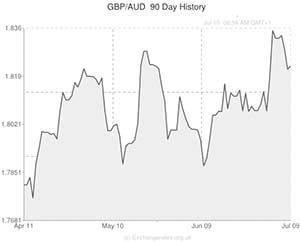
Over the course of Australasian trading, the Pound to Australian Dollar (GBP/AUD) exchange rate surged by over 0.4% as investors ditched the ‘Aussie’ following the release of disappointing employment figures.
The Australian unemployment rate climbed from a revised 5.9% in May to 6.0% in June – taking the level of joblessness right back to where it started at the beginning of 2014.
The figure now matches the ten-year high recorded in January.
According to economist Ben Jarman; ‘For quite a while we have had this theme where the participation rate has been falling and that has probably been flattening the unemployment rate. If the participation rate has stabilised then it looks like this lack of genuine hiring appetite that we are seeing is going to translate to a higher unemployment rate.’
Although the Australian economy added over 15,000 positions in June (beating expectations for a 12,000 climb) the number of people looking for work also rose, with the participation rate edging up from 64.6% to 64.7%.
Full-time employment fell by 3,800 while part-time employment increased by 19,700.
The AUD/USD pairing shed a whopping 0.6% after the report was issued, taking the Australian Dollar well away from its recent one-week high against the ‘Greenback’.
Some Australian Dollar movement was also occasioned by Chinese trade data, which showed something of a rebound.
The value of Chinese imports fell by -1.6% in May, year-on-year, but advanced by 5.5% in June.
Similarly, the value of the nation’s exports rose by 7.2% in June on an annual basis, up from the +7.0% figure recorded in May.
However, these results did fall short of forecasts as economists had envisaged a 6.0% increase in imports and a 10.4% jump in exports.
The report saw economist Chen Xingdong comment; ‘External demand can support China’s economy, but that support isn’t strong. To drive China’s growth we still have to go back to the domestic market.’
Although a report showed that the UK’s trade deficit unexpectedly widened in May, the Pound to Australian Dollar (GBP/AUD) exchange rate held on to its earlier gains.
It has been forecast that the GBP/AUD pairing will continue trading in a stronger position for the rest of the European session.
During Australasian trading, Australia’s Home Loans and Investment Lending reports could influence the Pound to Australian Dollar exchange rate.
UPDATED 09:10 GMT 11 July, 2014
Pound to Australian Dollar Edges Down before Weekend
On Friday the Australian Dollar recovered from the extensive losses sustained following the release of disappointing Australian employment figures.
The fact that Australia’s unemployment rate climbed to 6.0% (the same ten-year high recorded earlier in the year) weighed heavily on the South Pacific asset.
However, the Pound to Australian Dollar exchange rate pared gains as the UK’s trade figures flopped and the Bank of England delivered a far-from-ground breaking interest rate decision.
Overnight the Australian Dollar experienced minimal fluctuations following the release of domestic data.
The Australian Home Loans report for May showed stagnation father than the -0.5% decline expected, but April’s figure was revised to a decline of -0.2%.
Investment lending was shown to have fallen by -0.9% in May while the Value of Loans decreased by -0.7%.
Despite this, the AUD/USD exchange rate was able to push slightly higher.
With the weekend fast approaching, any additional movement in the Pound to Australian Dollar (GBP/AUD) exchange rate is likely to be the result of the UK’s Construction Output data.
Australian Dollar (AUD) Exchange Rates
[table width=”100%” colwidth=”50|50|50|50|50″ colalign=”left|left|left|left|left”]
Currency, ,Currency,Rate ,
Australian Dollar, ,US Dollar, 0.9364,
,US Dollar, 0.9364,
Australian Dollar, ,Euro, 0.6869,
,Euro, 0.6869,
Australian Dollar, ,Pound, 0.5470,
,Pound, 0.5470,
Australian Dollar, ,New Zealand Dollar, 1.0634,
,New Zealand Dollar, 1.0634,
US Dollar, ,Australian Dollar, 1.0675,
,Australian Dollar, 1.0675,
Euro, ,Australian Dollar, 1.4551,
,Australian Dollar, 1.4551,
Pound Sterling, ,Australian Dollar, 1.8278,
,Australian Dollar, 1.8278,
New Zealand Dollar, ,Australian Dollar, 0.9402,
,Australian Dollar, 0.9402,
[/table]

Comments are closed.